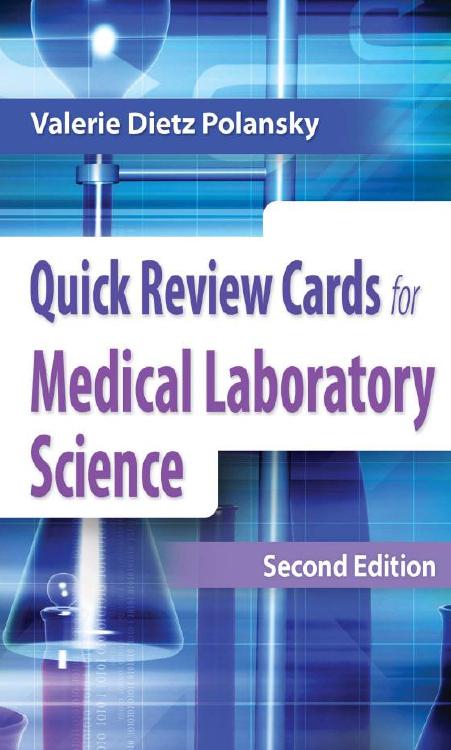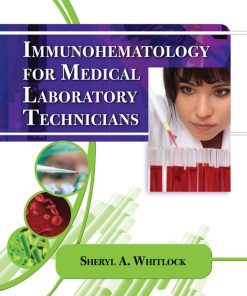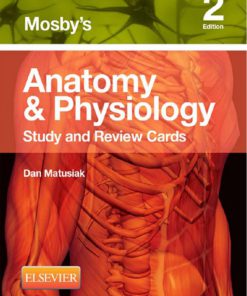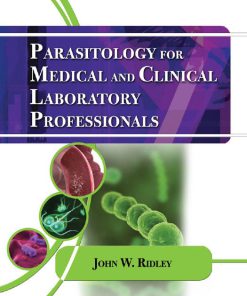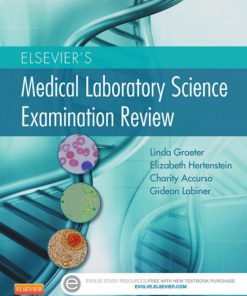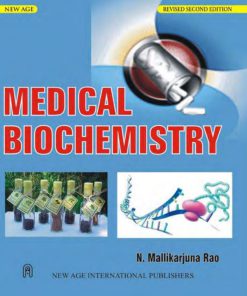Quick Review Cards for Medical Laboratory Science 2nd edition by Valerie Dietz Polansky 9780803641037 0803641036
$50.00 Original price was: $50.00.$25.00Current price is: $25.00.
Authors:Valerie Dietz Polansky , Series:Pathology [38] , Tags:Medical; Allied Health Services; Medical Technology , Author sort:Polansky, Valerie Dietz , Ids:9780803629561 , Languages:Languages:eng , Published:Published:Apr 2014 , Publisher:F a Davis Company , Comments:Comments:A complete study guide! Use these handy cards for course review now…and exam prep later. More than 500 cards deliver concise, but complete coverage of the major disciplines on the Board of Certification’s content outline and practice today.
Quick Review Cards for Medical Laboratory Science 2nd edition by Valerie Dietz Polansky – Ebook PDF Instant Download/Delivery.9780803641037, 0803641036
Full download Quick Review Cards for Medical Laboratory Science 2nd edition after payment
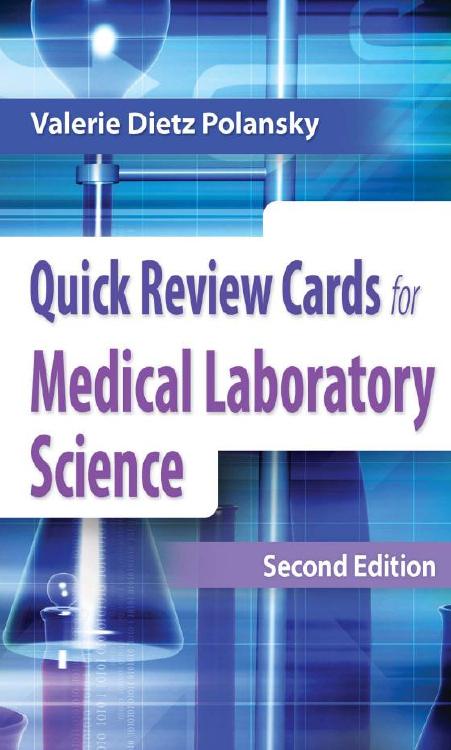
Product details:
ISBN 10: 0803641036
ISBN 13: 9780803641037
Author: Valerie Dietz Polansky
A complete study guide! Use these handy cards for course review now…and exam prep later.
More than 500 cards deliver concise, but complete coverage of the major disciplines on the Board of Certification’s content outline and practice today.
Quick Review Cards for Medical Laboratory Science 2nd Table of contents:
Section 1 Laboratory Operations Review
- Credentialing
- Agencies That Issue Guidelines/Standards
- Federal Regulatory Agencies
- Federal Regulations
- CLIA ‘88 Test Complexities
- Bloodborne Pathogens Standard
- Specimen Infectivity
- Packaging of Biologics for Shipping
- Hazard Communication Standard (HCS)
- Occupational Exposures to Hazardous Chemicals in Laboratories Standard
- Hazard Categories of Chemicals
- Hazard Identification System
- Storage of Chemicals
- Fire Safety
- Commonly Used Anticoagulants/Additives
- Recommended Order for Drawing Evacuated Tubes & Filling Tubes From a Syringe
- Recommended Order for Filling Microcollection Tubes From Capillary Punctures
- Special Situations in Phlebotomy
- Special Test Requirements
- Phlebotomy Sources of Error
- Guidelines for Specimen Handling & Processing
- Centrifuges
- Examples of Criteria for Specimen Rejection
- Types of Glass
- Types of Plastic
- Glassware Inscriptions
- Volumetric Glassware
- Glass Pipets
- Mechanical Micropipets
- Grades of Chemicals
- Purified Water
- CAP Reagent Labeling Requirements
- Brightfield Microscopy
- Other Types of Microscopy
- Informatics
- Computer Hardware
- Computer Software
- Information Systems
- Computer Networks
- Quality Assessment
- Quality Control
- Quality Control Statistics
- Interpretation of Quality Control Data
- Westgard Multirules
- Typical Steps Taken When a Control Is Outside Acceptable Range
- Calibration
- Test Performance Specifications and Verification
- Diagnostic Value of a Test
- Other Components of a QA Program
- CLIA Requirements for Procedure Manuals
- Ethical and Legal Issues
- Commonly Used Prefixes in the Metric System
- General Laboratory Calculations
Section 2 Clinical Chemistry Review
- Comparison of Conventional and SI Units for Selected Reference Ranges
- Examples of Patient Variables That May Affect Chemistry Values
- Examples of Preanalytical Factors That May Affect Chemistry Results
- Differences in Analyte Concentrations
- Photometric Methods
- Visible Light
- Wavelengths Used in Spectrophotometry
- Chromatography
- Other Analytic Techniques
- Steps in Automated Analysis
- Chemistry Panels
- Carbohydrates, Lipids, and Proteins
- Regulation of Glucose
- Diabetes Mellitus
- Tests for Diabetes Mellitus
- Typical Laboratory Findings in Uncontrolled Diabetes Mellitus
- Metabolic Syndrome
- Aminoacidopathies
- Protein Electrophoresis
- Common Serum Protein Electrophoresis Patterns
- Nonprotein Nitrogen Compounds
- Major Electrolytes
- Other Electrolytes
- Iron and Related Tests
- Factors That Influence Enzymatic Reactions
- Enzymes of Clinical Significance
- Summary of Diagnostic Enzymology
- Cardiac Markers for Diagnosis of Acute Myocardial Infarction
- Other Cardiac Tests
- Bilirubin Metabolism
- Types of Bilirubin
- Unconjugated Versus Conjugated Bilirubin
- Differential Diagnosis of Jaundice
- Pituitary Hormones
- Thyroid and Parathyroid Hormones
- Thyroid Function Testing
- Adrenal Hormones
- Reproductive Hormones
- Pancreatic Hormones
- Therapeutic Drug Monitoring (TDM)
- Therapeutic Drug Groups
- Toxic Agents
- Drugs of Abuse Urine Screen
- Common Tumor Markers
- Acid-Base Balance Terminology
- Acid-Base Imbalances
- Arterial Blood Gases Terminology
- Blood Gas Parameters
- Blood Gas Instrumentation
- Sources of Error in Arterial Blood Gases
- Calculated Chemistry Values
- Chemistry Calculations
Section 3 Clinical Microbiology Review
- Biosafety Levels
- Centers for Disease Control and Prevention Classification of Biological Agents
- Biological Safety Cabinets
- Sterilization and Disinfection
- Bacterial Toxins
- Specimen Collection Guidelines
- Specimen Preservation and Storage
- Fragile Organisms
- Criteria for Rejection of Specimens in Microbiology
- Gram Stain
- Staining Properties of Gram-Positive and Gram-Negative Bacteria
- Types of Media
- Routine Media for Aerobes and Facultative Anaerobes
- Selective Media for Isolation of Aerobic and Anaerobic Bacteria
- Special Bacteriologic Media
- Aerotolerance Test
- Organisms Requiring Incubation in Increased CO2
- Hemolytic Reactions on Sheep Blood Agar
- Staphylococci
- Summary of Tests for Identification of Staphylococci
- Streptococci/Enterococci
- Tests for Identification of Beta-Hemolytic Streptococci
- Tests for Identification of Alpha-Hemolytic Streptococci
- Tests for Identification of Nonhemolytic Streptococci/Enterococci
- Antibiograms of Gram-Positive Cocci
- Aerobic Spore-Forming Gram-Positive Rods
- Aerobic Non–Spore-Forming Gram-Positive Rods
- Neisseria and Moraxella
- Characteristics of Enterobacteriaceae
- Biochemical Tests for Identification of Enterobacteriaceae
- Antigens of Enterobacteriaceae
- Commonly Isolated Enterobacteriaceae
- Summary of Key Reactions for Enterobacteriaceae
- Appearance of Enterobacteriaceae on Selected Media
- Diarrheagenic Enterobacteriaceae
- Characteristics of Nonfermenting Gram-Negative Rods
- Commonly Isolated Nonfermenting Gram-Negative Rods
- Campylobacter and Helicobacter
- Vibrio and Related Organisms
- Speciation of Haemophilus
- Miscellaneous Gram-Negative Rods
- Specimens for Anaerobic Culture
- Media for Culture of Anaerobes
- Anaerobic Environment
- Methods to Identify Anaerobes
- Anaerobic Gram-Positive Cocci
- Anaerobic Gram-Positive Rods
- Gram-Negative Anaerobes
- Laboratory Identification of Mycobacteria
- Acid-Fast Stains
- Classification of Mycobacteria Based on Pathogenicity
- Classification of Nontuberculous Mycobacteria Based on Physiology
- Medically Important Mycobacteria
- Chlamydia and Chlamydophila
- Spirochetes
- Mycoplasma/Ureaplasma
- Routine Culture Setup and Interpretation
- Fecal Pathogens
- Major Classes of Antibiotics
- Disk Diffusion Susceptibility Method (Kirby Bauer)
- Other Susceptibility Tests
- Automated Identification and Susceptibility Testing
- Examples of Quality Control in Microbiology Labs
- Stool Specimens for Ova and Parasites
- Ova and Parasite Examination
- Intestinal Amebae
- Flagellates of the Intestinal and Urogenital Tracts
- Intestinal Ciliates
- Intestinal Sporozoans
- Intestinal Nematodes
- Intestinal Cestodes
- Trematodes
- Blood and Tissue Protozoa
People also search for Quick Review Cards for Medical Laboratory Science 2nd :
uick review cards for medical laboratory science 2nd edition
quick review cards for medical lab science
quick review cards for clinical laboratory science examinations
questions to ask a medical laboratory scientist
You may also like…
eBook PDF
Mosby Anatomy Physiology Study and Review Cards 2nd edition by Dan Matusiak 9780323187268 0323187269
eBook PDF
CliffsNotes Algebra I Quick Review 2nd edition by Jerry Bobrow ISBN 0470880287 978-0470880289
eBook PDF
Cliffs Quick Review Biochemistry II 1st edition by Frank Schmidt ISBN 0764585622 9780764585623

